Footbridge connecting Revenue Tower and Fortis Tower over Gloucester Road, Wan Chai
Furious, she storms off from the Cheung family’s electrical appliances store on Hennessy Road, passing mindlessly through Southorn Playground, takes a right turn and stomps along Luard Road. With no destination in mind, Oi Lin suddenly finds herself alone on a nameless footbridge leading to the Revenue Tower on Gloucester Road. Here, she decides to stop, contemplating and crying over the complications of her circumstances.
This sequence in “Crossing Hennessy” (2010, dir. by Ivy Ho) takes place after the Cheung mother accuses Oi Lin’s uncle and aunt of insincerity in attempting to matchmake Oi Lin and her son, Loy. Feeling wronged but defenceless (as she does have a boyfriend, albeit disapproved of by her uncle), Oi Lin catches an amalgam of complicated emotions and breaks off her budding friendship with Loy. This becomes a pivotal point in the film as their brief separation allows both to realise their subtle feelings for each other, leading to an eventual romance.
There are two comparisons to be made between the way the footbridge is presented in the film and experienced in real life, both of which providing important readings into the character’s emotions and the film’s portrayal of Wan Chai. The first is the role of the footbridge as a destination in itself, atypical of their usual purpose of connecting or delivering from one location to another. As a destination, this footbridge serves to provide a space of tranquility to shield the distressed Oi Lin from the overstimulating surroundings of one of the busiest districts of the city, and from this elevation, she stares into the flow of traffic passing through below the bridge and imagines her worries being carried away by the automobiles. It’s not difficult to understand why this footbridge in particular was chosen for this scene – even in real life, its existence as a pedestrian instrument seems redundant: just some 3-minute walk away, the O’Brien Road Overpass completely parallel to it, is one of the most utilised footbridges in Hong Kong, spanning over 5 roads in Wan Chai. In stark contrast, Oi Lin’s bridge seems isolated, motionless, useless.
The second comparison is the amount of greenery to be found on this footbridge. In the film, the bridge is characterised by its extent of greenery – from the bushy potted plants lining the side of the bridge, to the pastel green colour of the infrastructure itself, and even Oi Lin’s olive-coloured shirt – every bit of this footbridge is portrayed to emphasise its presence as an urban oasis, an uninterrupted plain amidst the concrete jungle. I suspect that the film strategically places the line of bushy plants along the side of the bridge facing the O’Brien Road Overpass so as to highlight Oi Lin’s attempt to shield herself from the drama and discourse of Wan Chai, and to further highlight that the bridge is a place where she can breathe, literally and figuratively.
-Kwong Hoi Shan, 3035663588
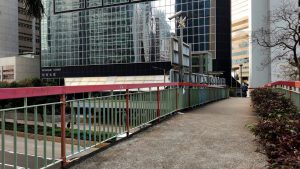
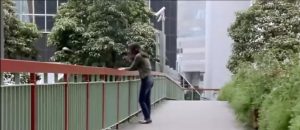
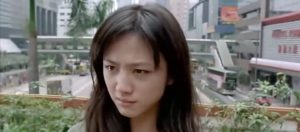
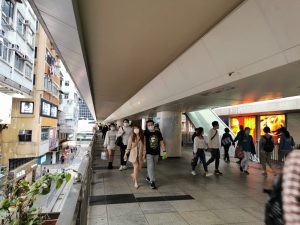
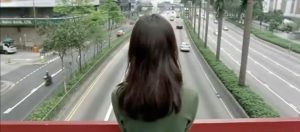
Appreciate your close analysis of how the film describes the footbridge as a place and not merely a transitional space or infrastructure of urban mobility. Enjoy your reading of the use of the “nameless bridge” instead of the O’Brien overpass. Though there could possibly be other reasons that resulted in the use of this particular bridge, your analysis of it being of less frequent use to the extent of being redundant is a thoughtful one. That the bridge is a destination and a tranquil space with greenery blocking out the city and traffic, extending the public discourse of greenery offering breathing spaces to the overbuilt commercial district, is effectively described in your writing and matching shots that you took of the bridge. What about Gloucester Road in the film and the actual road during the weekday working hours when Oi Lin spends there? Is it as green? Is the actual bridge space more or less noisy? Following your discussion on the bridge as space of tranquility, in what ways do the actual audio and ambient sounds at the site differ from the film’s depiction? A reflection on Augé’s identification of non-places and how this seeming urban infrastructure of “non-place” becomes a place for Oi Lin could offer further insights on the many other such non-places in the district and in the city.